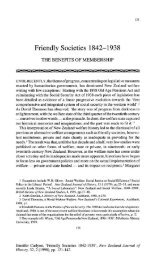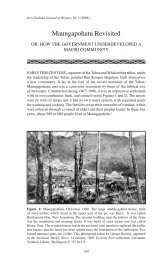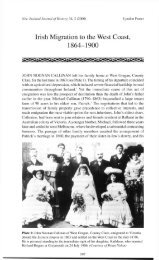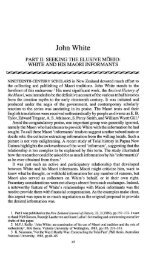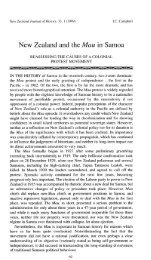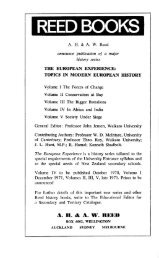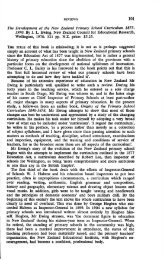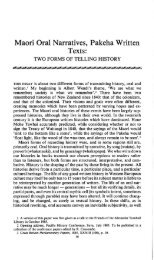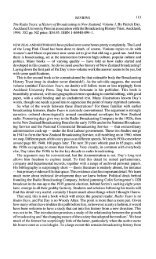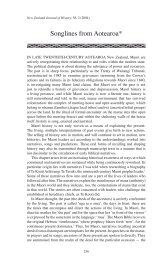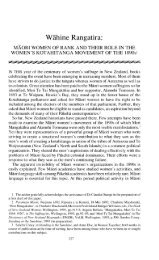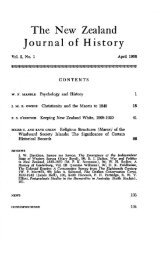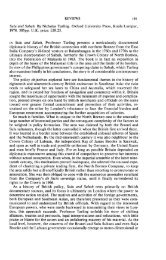Bishop G. A. Selwyn and the Melanesian Mission - New Zealand ...
Bishop G. A. Selwyn and the Melanesian Mission - New Zealand ...
Bishop G. A. Selwyn and the Melanesian Mission - New Zealand ...
You also want an ePaper? Increase the reach of your titles
YUMPU automatically turns print PDFs into web optimized ePapers that Google loves.
BISHOP G. A. SELWYN AND THE MELANESIAN MISSION 123<br />
frontier. This police work should be carried out by a patrolling warship,<br />
under 'a really enlightened naval officer', which would radiate<br />
'moral influence' <strong>and</strong> 'good example' in place of <strong>the</strong> customary technique<br />
of retaliatory bombardment. 12 As a Christian bishop he would<br />
willingly co-operate with <strong>the</strong> captain in this work of pacification: 'I<br />
would . . . serve under him as Chaplain on board <strong>the</strong> Undine [his<br />
episcopal schooner] acting as Tender to <strong>the</strong> Man of War, for <strong>the</strong><br />
purpose of establishing peaceful <strong>and</strong> Christian relations with all <strong>the</strong><br />
Isl<strong>and</strong>ers who are now implicated in past massacres, <strong>and</strong> of assuring<br />
<strong>the</strong>m of a general amnesty for <strong>the</strong> past, upon <strong>the</strong> condition of peaceful<br />
<strong>and</strong> friendly behaviour for <strong>the</strong> future.' 13 In this way, so <strong>Selwyn</strong><br />
reasoned, British naval justice would serve as a preparatio evangelica<br />
for <strong>the</strong> pagan isl<strong>and</strong>s of <strong>the</strong> south-west Pacific.<br />
It was against <strong>the</strong> background of Grey's imperialist ambitions <strong>and</strong><br />
<strong>the</strong> experiences accumulated during his isl<strong>and</strong> voyage that <strong>Selwyn</strong><br />
drew up plans for a mission to <strong>the</strong> <strong>Melanesian</strong> portion of his diocese.<br />
Unfortunately for his gr<strong>and</strong> design, he was not <strong>the</strong> first missionary<br />
on <strong>the</strong> scene. The martyrdom of John Williams had stimulated <strong>the</strong><br />
L.M.S. to continue <strong>the</strong> work he had begun, <strong>and</strong> during <strong>the</strong> 1840s<br />
Samoan <strong>and</strong> <strong>the</strong> Rarotongan teachers were sent to a number of places<br />
in <strong>the</strong> <strong>New</strong> Hebrides, <strong>New</strong> Caledonia <strong>and</strong> <strong>the</strong> Loyalty Isl<strong>and</strong>s. The<br />
Marist Fa<strong>the</strong>rs, after abortive attempts to found missions at Balade<br />
<strong>and</strong> Puebo on <strong>New</strong> Caledonia <strong>and</strong> on San Cristobal in <strong>the</strong> Solomons,<br />
were in <strong>the</strong> process of failing in ano<strong>the</strong>r on isl<strong>and</strong>s off <strong>the</strong> eastern<br />
coast of <strong>New</strong> Guinea. Presbyterians from Nova Scotia were on <strong>the</strong>ir<br />
way to <strong>the</strong> <strong>New</strong> Hebrides where, in July 1848, <strong>the</strong>y settled on Aneityum.<br />
These Christian efforts had been small in scale, hesitant in<br />
execution <strong>and</strong>, in contrast to <strong>the</strong> mass conversions which had occurred<br />
elsewhere in <strong>the</strong> Pacific, markedly unsuccessful, but <strong>the</strong>y could not<br />
be ignored. It was <strong>Selwyn</strong>'s error to underestimate <strong>the</strong> attachment of<br />
o<strong>the</strong>r missionary bodies to <strong>the</strong> vision of a Melanesia christianized in<br />
<strong>the</strong>ir own image.<br />
Behind <strong>Selwyn</strong>'s plan for <strong>the</strong> mission lay two fundamental assumptions:<br />
first, that native converts should be spared <strong>the</strong> unedifying<br />
spectacle of competing Christian creeds; second, that Nature had<br />
'marked out for each missionary body its field of duty'. 14 For himself<br />
he had no doubt that Providence was calling <strong>the</strong> Church of Engl<strong>and</strong><br />
through his Letters Patent <strong>and</strong> Howley's commission to take a lead in<br />
<strong>the</strong> evangelization of <strong>the</strong> whole of Melanesia <strong>and</strong> 'carry <strong>the</strong> Gospel<br />
into every isl<strong>and</strong> which has not received it'. 15 He would respect <strong>the</strong><br />
12 See Tucker, I, 310-1, 312-4; Extracts from. <strong>New</strong> Zeal<strong>and</strong> Letters during <strong>the</strong><br />
years 1851-2, Eton, 1853, pp. 15-6; Letters, p. 44; <strong>Selwyn</strong> to W. E. Gladstone.<br />
31 October 1848 <strong>and</strong> 17 November 1850, 'G. A. <strong>Selwyn</strong>, Letters to Gladstone<br />
1828-1860', microfilm, Alex<strong>and</strong>er Turnbull Library, Wellington. For a general<br />
discussion of this topic, see W. N. Gunson, '<strong>Mission</strong>ary Interest in British Expansion<br />
in <strong>the</strong> South Pacific in <strong>the</strong> Nineteenth Century', The Journal of Religious<br />
History, III, 4 (December 1965), 296-313.<br />
13 <strong>Selwyn</strong> to Gladstone, 31 October 1848, he. cit.<br />
i* Tucker, I, 255.<br />
15 ibid., I, 287, 290.



